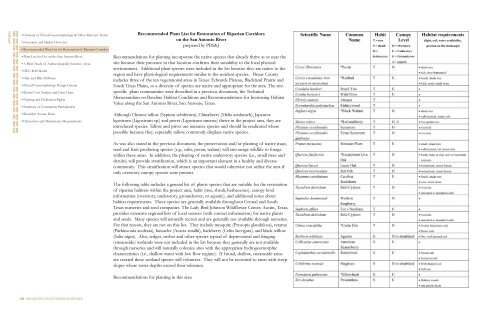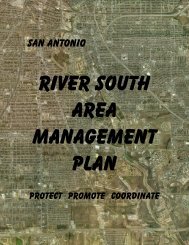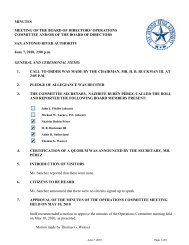concept design san antonio river improvements project
concept design san antonio river improvements project
concept design san antonio river improvements project
Create successful ePaper yourself
Turn your PDF publications into a flip-book with our unique Google optimized e-Paper software.
APPENDIX<br />
• Glossary of Fluvial Geomorphologic & Other Relevant Terms<br />
• Economic and Market Overview<br />
• Recommended Plant List for Restoration of Riparian Corridors<br />
• Plant List for Use on the San Antonio River<br />
• A Brief Study of Archaeologically Sensitive Areas<br />
• HEC-RAS Model<br />
• Hike and Bike Pathways<br />
• Fluvial Geomorphology Design Criteria<br />
• Master Cost Analysis and Gant Chart<br />
• Naming and Dedication Rights<br />
• Summary of Community Participation<br />
• Brooklyn Avenue Dam<br />
• Operations and Maintenance Requirements<br />
106 SAN ANTONIO RIVER DESIGN GUIDELINES<br />
Recommended Plant List for Restoration of Riparian Corridors<br />
on the San Antonio River<br />
prepared by PBS&J<br />
Recommendations for planting incorporate the native species that already thrive at or near the<br />
site because their presence in that location confirms their suitability to the local physical<br />
environment. Additional plant species were included in the list because they are native to the<br />
region and have physiological requirements similar to the resident species. Bexar County<br />
includes three of the ten vegetational areas in Texas: Edwards Plateau, Blackland Prairie and<br />
South Texas Plains, so a diversity of species are native and appropriate for the area. The sitespecific<br />
plant communities were described in a previous document, the Technical<br />
Memorandum on Baseline Habitat Conditions and Recommendations for Increasing Habitat<br />
Value along the San Antonio River, San Antonio, Texas.<br />
Although Chinese tallow (Sapium sebiferum), Chinaberry (Melia azedarach), Japanese<br />
ligustrum (Ligustrum sp.) and privet (Ligustrum sinense) thrive in the <strong>project</strong> area, they are<br />
introduced species. Tallow and privet are nui<strong>san</strong>ce species and should be eradicated where<br />
possible because they, especially tallow, commonly displace native species.<br />
As was also stated in the previous document, the preservation and/or planting of native mast,<br />
seed and fruit producing species (e.g., oaks, pecan, walnut) will encourage wildlife to forage<br />
within these areas. In addition, the planting of native understory species (i.e., small trees and<br />
shrubs) will provide stratification, which is an important element in a healthy and diverse<br />
community. This stratification will attract species that would otherwise not utilize the area if<br />
only overstory canopy species were present.<br />
The following table includes a general list of plants species that are suitable for the restoration<br />
of riparian habitats within the <strong>project</strong> area, habit (tree, shrub, herbaceous), canopy level<br />
information (overstory, understory, groundcover, or aquatic), and additional notes about<br />
habitat requirements. These species are generally available throughout Central and South<br />
Texas nurseries and seed companies. The Lady Bird Johnson Wildflower Center, Austin, Texas,<br />
provides extensive regional lists of local sources (with contact information) for native plants<br />
and seeds. Many species will naturally recruit and are generally not available through nurseries.<br />
For that reason, they are not on this list. They include mesquite (Prosopis glandulosa), retama<br />
(Parkinsonia aculeata), huisache (Acacia smallii), hackberry (Celtis laevigata), and black willow<br />
(Salix nigra). Also, sedges, rushes and other species typical of depressional and fringing<br />
(streamside) wetlands were not included in the list because they generally are not available<br />
through nurseries and will naturally colonize sites with the appropriate hydrogeomorphic<br />
characteristics (i.e., shallow water with low flow regime). If broad, shallow, streamside areas<br />
are created these wetland species will volunteer. They will not be recruited to areas with steep<br />
slopes where water depths exceed their tolerance.<br />
Recommendations for planting in this area






